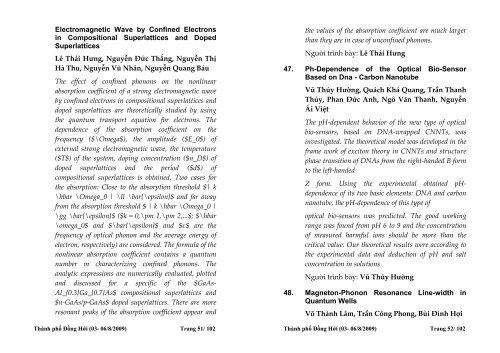Quyá»n tóm tắt (pdf) - Viá»n Váºt lý
Quyá»n tóm tắt (pdf) - Viá»n Váºt lý
Quyá»n tóm tắt (pdf) - Viá»n Váºt lý
- No tags were found...
You also want an ePaper? Increase the reach of your titles
YUMPU automatically turns print PDFs into web optimized ePapers that Google loves.
Electromagnetic Wave by Confined Electronsin Compositional Superlattices and DopedSuperlatticesLê Thái Hưng, Nguyễn Đức Thắng, Nguyễn ThịHà Thu, Nguyễn Vũ Nhân, Nguyễn Quang BáuThe effect of confined phonons on the nonlinearabsorption coefficient of a strong electromagnetic waveby confined electrons in compositional superlattices anddoped superlattices are theoretically studied by usingthe quantum transport equation for electrons. Thedependence of the absorption coefficient on thefrequency ($\Omega$), the amplitude ($E_0$) ofexternal strong electromagnetic wave, the temperature($T$) of the system, doping concentration ($n_D$) ofdoped superlattices and the period ($d$) ofcompositional superlattices is obtained. Two cases forthe absorption: Close to the absorption threshold $| k\hbar \Omega_0 | \ll \bar{\epsilon}$ and far awayfrom the absorption threshold $ | k \hbar \Omega_0 |\gg \bar{\epsilon}$ ($k = 0,\pm 1,\pm 2,...$; $\hbar\omega_0$ and $\bar{\epsilon}$ and $ε$ are thefrequency of optical phonon and the average energy ofelectron, respectively) are considered. The formula of thenonlinear absorption coefficient contains a quantumnumber m characterizing confined phonons. Theanalytic expressions are numerically evaluated, plottedand discussed for a specific of the $GaAs-Al_{0.3}Ga_{0.7}As$ compositional superlattices and$n-GaAs/p-GaAs$ doped superlattices. There are moreresonant peaks of the absorption coefficient appear andThành phố Đồng Hới (03- 06/8/2009) Trang 51/ 102the values of the absorption coefficient are much largerthan they are in case of unconfined phonons.Người trình bày: Lê Thái Hưng47. Ph-Dependence of the Optical Bio-SensorBased on Dna - Carbon NanotubeVũ Thúy Hường, Quách Khả Quang, Trần ThanhThúy, Phan Đức Anh, Ngô Văn Thanh, NguyễnÁi ViệtThe pH-dependent behavior of the new type of opticalbio-sensors, based on DNA-wrapped CNNTs, wasinvestigated. The theoretical model was developed in theframe work of exciton theory in CNNTs and structurephase transition of DNAs from the right-handed B formto the left-handedZ form. Using the experimental obtained pHdependenceof its two basic elements: DNA and carbonnanotube, the pH-dependence of this type ofoptical bio-sensors was predicted. The good workingrange was found from pH 6 to 9 and the concentrationof measured harmful ions should be more than thecritical value. Our theoretical results were according tothe experimental data and deduction of pH and saltconcentration in solutionsNgười trình bày: Vũ Thúy Hường48. Magneton-Phonon Resonance Line-width inQuantum WellsVõ Thành Lâm, Trần Công Phong, Bùi Đình HợiThành phố Đồng Hới (03- 06/8/2009) Trang 52/ 102















